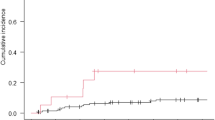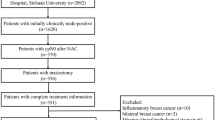Background:
To analyze prognostic factors in patients with a glioblastoma multiforme treated in an academic institute over the last 10 years.
Patients and Method: From 1988 to 1998, 198 patients with pathologically confirmed glioblastoma multiforme were analyzed. Five radiation schedules were used mainly based on pretreatment selection criteria: 1. 60 Gy in 30 fractions followed by an interstitial iridium-192 (Ir-192) boost for selected patients with a good performance and a small circumscribed tumor, 2. 66 Gy in 33 fractions for good performance patients, 3. 40 Gy in eight fractions or 4. 28 Gy in four fractions for poor prognostic patients and 5. no irradiation.
Results: Median survival was 16 months, 7 months, 5.6 months, 6.6 months and 1.8 months for the groups treated with Ir-192, 66 Gy, 40 Gy, 28 Gy and the group without treatment, respectively. No significant improvement in survival was encountered over the last 10 years. At multivariate analysis patients treated with a hypofractional scheme showed a similar survival probability and duration of palliative effect compared to the conventionally fractionated group. The poor prognostic groups receiving radiotherapy had a highly significant better survival compared to the no-treatment group. Patients treated with an Ir-192 boost had a better median survival compared to a historical group matched on selection criteria but without boost treatment (16 vs 9.7 months, n. s.). However, survival at 2 years was similar. Analysis on pretreatment characteristics at multivariate analysis revealed age, neurological performance, addition of radiotherapy, total resection, tumor size post surgery and deterioration before start of radiotherapy (borderline) as significant prognostic factors for survival.
Conclusion: Despite technical developments in surgery and radiotherapy over the last 10 years, survival of patients with a glioblastoma multiforme has not improved in our institution. The analysis of prognostic factors corresponded well with data from the literature. A short hypofractionated scheme seems to be a more appropriate treatment for patients with intermediate or poor prognosis as compared to a conventional scheme. The benefit in median survival for patients treated with an interstitial boost is partly explained by patient selection. Since there were no long-term survivors with this boost treatment, its clinical value, if there is one, is still limited.
Hintergrund:
Es wurden Prognosefaktoren bei Patienten mit Glioblastoma multiforme ermittelt, die über einen Zeitraum von 10 Jahren in einer Institution behandelt wurden.
Patienten und Methoden: Die Analyse beruht auf 198 Patienten, die von 1988 bis 1998 nach histologischer Sicherung fünf verschiedenen Bestrahlungsschemata zugeführt wurden: 1. 60 Gy in 30 Fraktionen gefolgt von einem Ir-192-(LDR-)Boost bei selektierten Patienten mit gutem Performance-Status und kleinen Tumoren, 2. 66 Gy in 33 Fraktionen bei Patienten mit gutem Performance-Status, 3. 40 Gy in acht Fraktionen oder 4. 28 Gy in vier Fraktionen bei Patienten in schlechtem Allgemeinzustand, 5. keine Bestrahlung.
Ergebnisse: Das mediane Überleben betrug 16 Monate für die Ir-192-Boost-Gruppe, 7 Monate nach 66 Gy, 5,6 Monate nach 40 Gy, 6,6 Monate nach 28 Gy und 1,8 Monate für unbehandelte Patienten. Über den Behandlungszeitraum von 10 Jahren waren keine signifikanten Verbesserungen der Überlebensraten zu verzeichnen. In der Multivarianzanalyse wiesen Patienten, die hypofraktioniert bestrahlt wurden, ähnliche Überlebenswahrscheinlichkeiten und Palliativeffekte auf wie Patienten nach konventioneller Bestrahlung. Die Strahlentherapie führte bei Patienten mit schlechtem Allgemeinzustand zu signifikanten Überlebenszeitverbesserungen im Vergleich zu Patienten ohne Behandlung. Verglichen mit einer historischen Kontrollgruppe ohne Ir-192-Boost-Bestrahlung hatten Patienten nach Ir-192-Boost-Bestrahlung nicht signifikante Verbesserungen der medianen Überlebensraten (16 Monate v. 9,7 Monate), wobei sich jedoch die 2-Jahres-Überlebensraten wieder angeglichen. In der Multivarianzanalyse waren Alter, neurologischer Status, Radiotherapie, totale Resektion, Resttumorgröße nach Resektion und Verschlecherung vor Anfang der Strahlentherapie (Grenzwert) für das Überleben signifikante Prognosefaktoren.
Schlussfolgerungen: Trotz technischer Entwicklungen sowohl im Bereich der Neurochirurgie als auch der Radiotherapie verbesserten sich die Überlebensraten von Patienten mit Glioblastoma multiforme in den letzten 10 Jahren in unserer Institution nicht. Die Analyse der Prognosefaktoren korreliert gut mit Angaben aus der Literatur. Für Patienten mit intermediärer oder schlechter Prognose ist ein abgekürztes hypofraktioniertes Bestrahlungsregime eine angemessene Therapieoption. Die beobachtete Verbesserung der medianen Überlebensraten nach Ir-192-Boost ist zumindest teilweise durch eine Patientenselektion erklärbar. Da diese Behandlungsform zu keinem Langzeitüberleben führt, ist der klinische Stellenwert weiterhin unklar.
Similar content being viewed by others
Author information
Authors and Affiliations
Additional information
Submitted: October 10, 2000; accepted: December 7, 2000
Rights and permissions
About this article
Cite this article
Hulshof, M., Koot, R., Schimmel, E. et al. Prognostic Factors in Glioblastoma Multiforme 10 Years Experience of a Single Institution. Strahlenther Onkol 177, 283–290 (2001). https://doi.org/10.1007/PL00002409
Issue Date:
DOI: https://doi.org/10.1007/PL00002409




